-
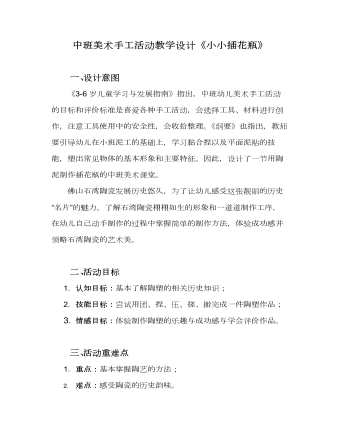
中班美术手工活动教学教案设计《小小插花瓶》
佛山石湾陶瓷发展历史悠久,为了让幼儿感受这张靓丽的历史“名片”的魅力,了解石湾陶瓷栩栩如生的形象和一道道制作工序,在幼儿自己动手制作的过程中掌握简单的制作方法,体验成功感并领略石湾陶瓷的艺术美。
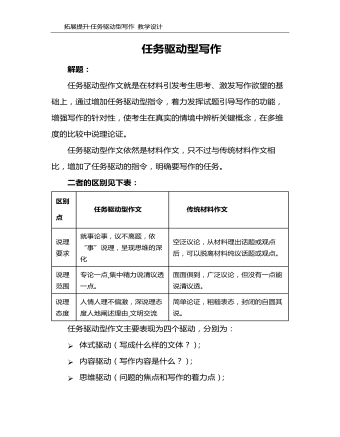
任务驱动型写作 教学教案设计
随着互联网自媒体的兴盛,不少人为了引起关注,吸引“粉丝”使出浑身解数。有人攀爬城市高楼,做出各种惊险动作,以赢得点击量;有“14岁荣升宝妈”的少女,靠展示自己的肚皮,获得打赏;9岁女孩在抖音发哭诉视频:“今天妈妈火化了,我再也见不到她了,求求你们,就给我一万个赞可以吗?”;有农村青年直播生吃青蛙、老鼠以求转发;有父亲虚构家庭处境,靠“卖惨”为“重病女儿”筹款……一个比一个奇异,一个比一个惊悚。
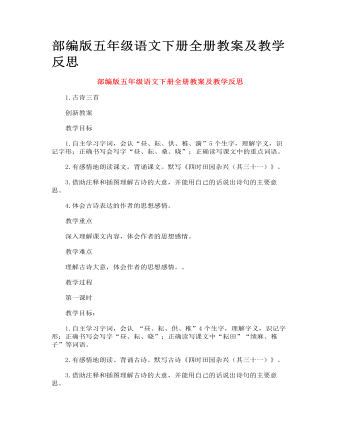
部编版五年级语文下册全册教案及教学反思
初读古诗,整体感知。 1.请同学们用自己喜欢的方式读古诗《四时田园杂兴》(其三十一)。要求借助拼音学会生字,把古诗读正确,读通顺。 2.指名多个学生朗读古诗,师生评议,纠正读得不准确的字音。尤其注意读准“昼、耘”的读音。指导读准多音字“供”([ gōng ]作动词时,准备着东西给需要的人应用:供应、供给(jǐ)、供求、供需、供销、提供、供不应求。[ góng ]奉献:供养、供献、供奉、供佛、供职;祭祀用的东西:供桌、供品、供果、上供;被审问时在法庭上述说事实:招供、口供、供状、供认、供词。)在诗中读四声。 3.把古诗反复多读几遍,通过查字典、问同学、问老师等方式,结合课文注释,理解诗句中词语的意思,用自己的话说说这首诗大体写了什么。记下不理解的地方和不明白的问题。 4.学生自愿举手发言,其他同学进行评议,也可以做补充发言。全班交流,教师相机引导并小结。
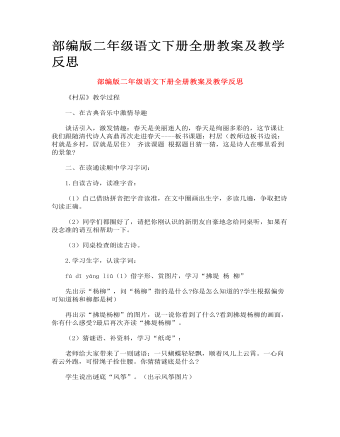
部编版二年级语文下册全册教案及教学反思
在入情入境中诵读成韵 1.配乐范读,想象画面: (1)学生边看插图边听老师配乐朗读,想象诗中所描绘的画面。 (2)学生自由交流想象中的画面,老师激励小结。 预设:山坡上的小草发芽了,嫩绿嫩绿的。黄莺在空中飞来飞去。河堤旁的柳条发芽了,几个下朋友放学回来,趁着东风,赶忙放起了风筝…… 2.借助插图,启发想象:黄莺一边飞一边干什么?(叽叽喳喳地叫)它好像在说什么? 再次启发想象:春风轻轻地吹来,柳条会怎样呢?(轻轻摆动,好像在跳舞陶醉在了美丽的春色里……) 诗人高鼎看到这样的景致写下了这样的诗句:出示“草长莺飞二月天,拂堤杨柳醉春烟”。(学生齐读) 让我们想象着春天的美丽景色,有滋有味地诵读。学生练读、指名读、引读。 3.联系生活,换位体验,:在这样美妙的春光里,沐浴着和煦的春风,(出示儿童放纸鸢图片)孩子们放起风筝,你们放过风筝吗?你放风筝时是怎样的心情?(学生自由发言)

新人教版高中英语必修2Unit 4 History and Traditions-Listening&Speaking&Talking教案二
Listening and Speaking introduces the topic of “Take part in a youth project”. The listening text is an interview about "sharing views on historical sites". Through listening to a dialogue between Chinese and foreign students on the way to the Confucius Temple, students can understand their views on the Confucius Temple, Confucius, Confucius' descendants and Confucius' educational thoughts, so as to realize and think about the profound influence of Confucius and his thoughts on Chinese historical tradition. At the same time, the dialogue naturally integrates English idioms and mentions Shakespeare, the British playwright, so as to provide language materials and context for students to understand English idioms and related cultural allusions, as well as to compare Chinese and foreign cultures, which is helpful for students to understand and express the language such as history, tradition, culture and custom significant impact.Text analysis: listening text is a dialogue between a British student and a Chinese student when he goes to the Confucius Temple. When William, a British student, visited the Confucius Temple, he asked Xiao Kong, a Chinese student, for directions. Xiao Kong was just going to the Confucius Temple to meet with the members of the research group, so they went together and exchanged their views on the Confucius Temple, Confucius, Confucius' descendants and Confucius' educational thoughts. From the perspective of foreign tourists, this paper describes their thoughts on Confucius, the great son of Confucius, who had a profound impact on Chinese history and cultural tradition, and his education.Listening and Talking introduces a visit to a historic tourist destination. Tourism is a common way to understand a country's history, culture, and customs and so on. Students listen to the dialogue between Xiao Yan, a youth hostel Usher, and Paul, a backpacker, to learn about Pingyao's famous historical and cultural attractions and Paul's travel experience and experience as a foreign tourist.

新人教版高中英语必修2Unit 4 History and traditions教案
这个地区有着深厚的传统。既学既练:为了让更多的外国游客了解中国文化,欣赏中国美丽的自然风光,感受中国发生的巨大变化,某外文杂志社将出版一本英语小册子来介绍中国的旅游景点。该杂志社邀请你为该小册子写一篇英语短文来介绍杭州,内容包括:1.杭州的位置(中国东南部)、面积(16 000多平方公里)及历史(2 200多年)等;2.杭州的旅游特色(自然风景、传统文化、特色小吃等);3.希望更多的游客来杭州参观。注意:1.词数80左右;2.可适当增加细节,以使行文连贯。Located in the southeast of China, Hangzhou is a beautiful city.Dating back more than 2,200 years, Hangzhou covers an area of more than 16,000 square kilometers.In Hangzhou, you can visit the West Lake, whose scenery is fascinating.In addition, you can’t miss its cultural relics and historical sites, from which you will learn more about excellent Chinese traditional culture and traditions.In Hangzhou, the special snacks are famous and visitors from different parts of the world think highly of them.As a tourist attraction, Hangzhou attracts a large number of visitors from home and abroad every year.Once you come to China, Hangzhou is a scenic spot you can’t miss.

新人教版高中英语必修2Unit 4 History and Traditions-Discovering Useful Structure教案一
Step 5 Practice一、完成下列句子。1. Judy and I _______________(把车停下来(park))in an underground car Park near Trafalgar Square, where we could ______________________(让我们的车充电(charge)).2. When we finally reached the service desk to ask for audio guides, we heard it ___________ that there were no audio guides____________(留下,剩下).3. We__________________________(发现自己对...很惊讶)the large number of visitors and the amount of noise at the entrance of the National Gallery.4. Judy ____________________(眼神专注于) Van Gogh’s Sunflowers. It was hard to approach the painting as there were so many people around.5. She ____________________(把这幅画的复制品装箱(box)) to ensure that it was delivered safely.答案:1.had our car parked get our car battery charged 2. announced left 3. found ourselves very surprised 4. had her eyes fixed on 5. had a copy of the painting boxed二、用过去分词对下列句子进行改写。1. Loch Ness was surrounded by beautiful natural landscape, which made it look amazing.2. Carl and his friend stayed with a generous family who offered them bread with butter and honey that was homemade.3. The family’s ancestors once attended to soldiers who were wounded in the First World War.4. The young people were attracted by the legend of Loch Ness. They watched over the lake with their cameras and binoculars, which were positioned on the hill.答案:1. Loch Ness surrounded by beautiful natural landscape looks amazing.2. Carl and his friends stayed with a generous family who offered them homemade bread with butter and honey.3. The family’s ancestors once attended to wounded soldiers in the First World War.4. The young people attracted by the legend of Loch Ness watched over the lake with their cameras and binoculars positioned on the hill.

新人教版高中英语必修2Unit 4 History and Traditions-Listening&Speaking&Talking教案一
This unit is about history and traditions. From the opening page, we can know that this unit will introduce the history and traditions around the world. As Marcus Garvey says “A people without the knowledge of their past history, origin and culture is like a tree without roots”, it is important for students to realize the importance and value of knowing the history and traditions and their further meanings. And this part ( listening and speaking ) is divided into two parts: Part A---share views on historic sites, Part B ---talk about a visit to a historic tourist destination. By talking with a foreigner, the speakers introduce the historic attractions and their cultures. Part A is that William, a British student, who was going to visit the Confucius Temple and a Chinese student, Xiao Kong, who was going to the Confucius Temple to meet with the members of the research group, went together and exchanged their views on the Confucius Temple, Confucius, Confucius' descendants and Confucius' educational thoughts. Part B is a conversation between Xiao Yan, a youth hostel receptionist and Paul, a backpacker about the feelings and experience after visiting the Chinese famous tourist attraction Pingyao.1. Guide students to understand the content of listening texts in terms of the whole and key details; 2. Cultivate students' ability to guess the meaning of words in listening; discuss with their peers how to talk about historic spots and great person.3. Instruct students to use functional sentences of showing one’s excitement, surprise and disappointment.1. Guide students to understand the content of listening texts in terms of the whole and key details; 2. Cultivate students' ability to discuss with their peers the related topics.3. Enable students to use the functional items of showing one’s excitement, surprise and disappointment.

新人教版高中英语必修2Unit 4 History and Traditions-Discovering Useful Structure教案二
This teaching period mainly deals with grammar: The past participle is used as attributive and objective complement.1. Guide students to review the basic usages of the past participle used as attributive and objective complement.2. Lead students to learn to use some special cases concerning the past participle used as attributive and objective complement flexibly.3. Strengthen students’ great interest in grammar learning.1. Help students to appreciate the function of the past participle used as attributive and objective complement.2. Instruct students to write essays using the past participle used as attributive and objective complement.Step1:温故而知新。Analyze the underlined phrases and then sum up the common usages of the past participles.1.(教材P41)They had castles built(build) all around England, and made changes to the legal system.2.(教材P42)They use the same flag, known(know) as the Union Jack,...3.(教材P42)Judy and I had our car parked(park) in an underground car park near Trafalgar Square, where we could get our car battery charged(charge).Common points: f the past participle used as attributive and objective complement.Step 2:过去分词作定语时的意义1.及物动词的过去分词作定语,在语态上表示被动;在时间上,常表示动作已经发生或完成,有时也不表示时间性。Our teacher watched us doing the experiment and gave us a satisfied smile at last.我们的老师看着我们做实验,最后给了我们一个满意的微笑。The plan put forward at the meeting will be carried out soon.会上提出的计划将很快被执行。2.不及物动词的过去分词作定语,它不表示被动意义,只强调动作完成。Many little kids like gathering fallen leaves in the yard.
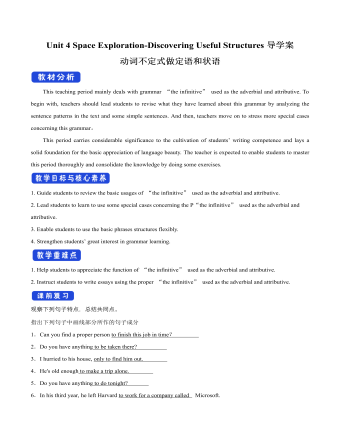
新人教版高中英语必修3Unit 4 Space Exploration-Discovering Useful Structures导学案
【点津】 1.不定式的复合结构作目的状语 ,当不定式或不定式短语有自己的执行者时,要用不定式的复合结构?即在不定式或不定式短语之前加 for +名词或宾格代词?作状语。He opened the door for the children to come in. 他开门让孩子们进来。目的状语从句与不定式的转换 英语中的目的状语从句,还可以变为不定式或不定式短语作状语,从而使句子在结构上得以简化。可分为两种情况: 1?当目的状语从句中的主语与主句中的主语相同时,可以直接简化为不定式或不定式短语作状语。We'll start early in order that/so that we may arrive in time. →We'll start early in order to/so as to arrive in time. 2?当目的状语从句中的主语与主句中的主语不相同时,要用动词不定式的复合结构作状语。I came early in order that you might read my report before the meeting. →I came early in order for you to read my report before the meeting.
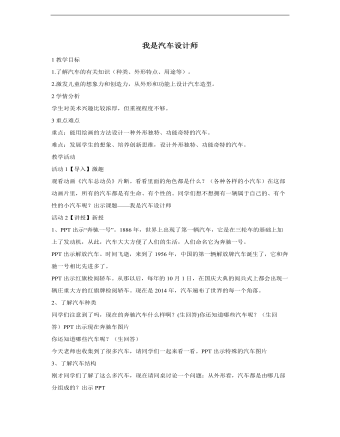
小学美术人教版四年级上册《第10课我是汽车设计师》教学设计说课稿
活动1【导入】激趣观看动画《汽车总动员》片断。看看里面的角色都是什么?(各种各样的小汽车)在这部动画片里,所有的汽车都是有生命、有个性的。同学们想不想拥有一辆属于自己的、有个性的小汽车呢?出示课题——我是汽车设计师活动2【讲授】新授1、PPT出示“奔驰一号”。1886年,世界上出现了第一辆汽车,它是在三轮车的基础上加上了发动机,从此,汽车大大方便了人们的生活,人们命名它为奔驰一号。PPT出示解放汽车。时间飞逝,来到了1956年,中国的第一辆解放牌汽车诞生了,它和奔驰一号相比先进多了。
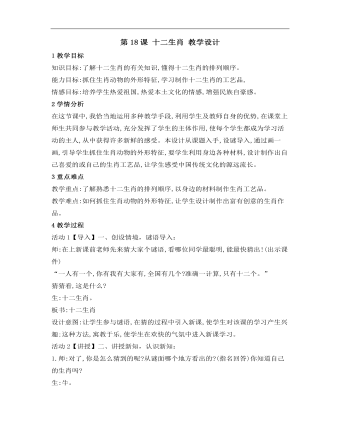
小学美术桂美版三年级上册《第18课十二生肖2》教学设计说课稿
2学情分析在这节课中,我恰当地运用多种教学手段,利用学生及教师自身的优势,在课堂上师生共同参与教学活动,充分发挥了学生的主体作用,使每个学生都成为学习活动的主人,从中获得许多新鲜的感受。本设计从课题入手,设谜导入,通过画一画,引导学生抓住生肖动物的外形特征,要学生利用身边各种材料,设计制作出自己喜爱的或自己的生肖工艺品,让学生感受中国传统文化的源远流长。
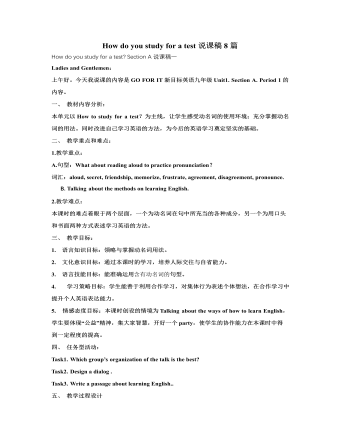
人教版新目标初中英语九年级上册How do you study for a test说课稿8篇
教学反思:这是学生升入初三的第一节课,学生学习热情很高,通过这一课时的学习,学生掌握了语言目标中所要求的知识重点、难点和语言技能,如by dong, practicing doing ,too……to,现在完成时态,动名词短语做主语及提建议的几种方式,但是有部分学生由于基础较差,还需要从培养学生学习兴趣入手,真正实现教育面向全体学生。在教学中采取的具体办法由:个别辅导,互助学习,留不同层次夫人作业,争取让每一位学生都吃饱而不掉队。How do you study for a test?Two periodsSection BGoals●To listen about learning English●To talk about learning English●To read about learning EnglishProceduresWarming up by reading to the recordingHello, everyone. To begin with, let’s listen and read to the recording of the text HOW DO YOU LEARN BEST? That is, read aloud to the tape, as fast as the tape goes, as clearly as the native reader reads. OK? Here we go!My cat speaks English. Sometimes my cat comes to me and tells me that she is hungry. Or that her leg hurts. How does my cat tell me these things? I don't speak pussy-cat language.1a Reading and checkingLearning English can be both easy and difficult. What things are easy for you? And what things are difficult for you? Now turn to page 5, read the list on the top and check √the statements that are true for you.1b Making a listYou have read and checked the statements true for you. Now think and make a list of other things difficult for you, too.
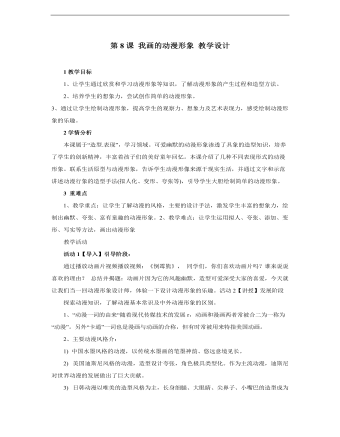
小学美术人教版四年级下册《第8课我画的动漫形象3》教学设计说课稿
2学情分析本课属于“造型.表现”,学习领域。可爱幽默的动漫形象渗透了具象的造型知识,培养了学生的创新精神,丰富着孩子们的美好童年回忆。本课介绍了几种不同表现形式的动漫形象。联系生活原型与动漫形象,告诉学生动漫形像来源于现实生活,并通过文字和示范讲述动漫行象的造型手法(拟人化、变形、夸张等),引导学生大胆绘制简单的动漫形象。3 重难点1、教学重点:让学生了解动漫的风格,主要的设计手法,激发学生丰富的想象力,绘制出幽默、夸张、富有童趣的动漫形象。2、教学难点:让学生运用拟人、夸张、添加、变形、写实等方法,画出动漫形象
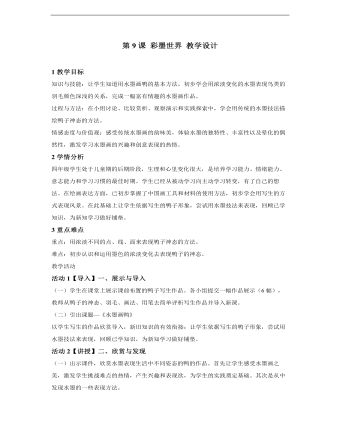
小学美术人教版四年级上册《第9课彩墨世界》教学设计说课稿模板
2学情分析四年级学生处于儿童期的后期阶段,生理和心里变化很大,是培养学习能力、情绪能力、意志能力和学习习惯的最佳时期。学生已经从被动学习向主动学习转变,有了自己的想法。在绘画表达方面,已初步掌握了中国画工具和材料的使用方法,初步学会用写生的方式表现风景。在此基础上让学生依据写生的鸭子形象,尝试用水墨技法来表现,回顾已学知识,为新知学习做好铺垫。
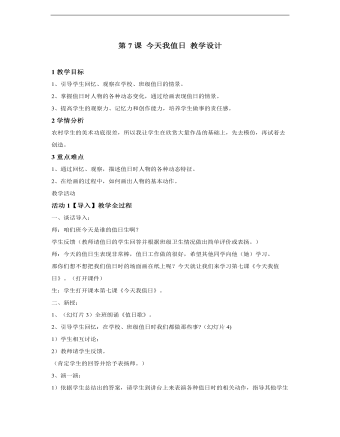
小学美术人教版四年级上册《第7课今天我值日》教学设计说课稿
一、谈话导入:师:咱们班今天是谁的值日生啊?学生反馈(教师请值日的学生回答并根据班级卫生情况做出简单评价或表扬。)师:今天的值日生表现非常棒,值日工作做的很好,希望其他同学向他(她)学习。那你们想不想把我们值日时的场面画在纸上呢?今天就让我们来学习第七课《今天我值日》。(打开课件)生:学生打开课本第七课《今天我值日》。
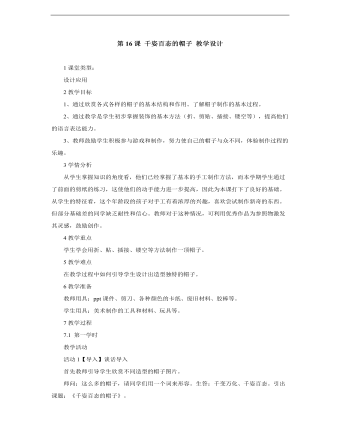
小学美术人教版四年级下册《第16课千姿百态的帽子》教学设计说课稿
1、通过欣赏各式各样的帽子的基本结构和作用。了解帽子制作的基本过程。2、通过教学是学生初步掌握装饰的基本方法(折、剪贴、插接、镂空等),提高他们的语言表达能力。3、教师鼓励学生积极参与游戏和制作,努力使自己的帽子与众不同,体验制作过程的乐趣。3学情分析从学生掌握知识的角度看,他们已经掌握了基本的手工制作方法,而本学期学生通过了前面的剪纸的练习,这使他们的动手能力进一步提高,因此为本课打下了良好的基础。从学生的特征看,这个年龄段的孩子对手工有着浓厚的兴趣,喜欢尝试制作新奇的东西。但部分基础差的同学缺乏耐性和信心。教师对于这种情况,可利用优秀作品为参照物激发其灵感,鼓励创作。
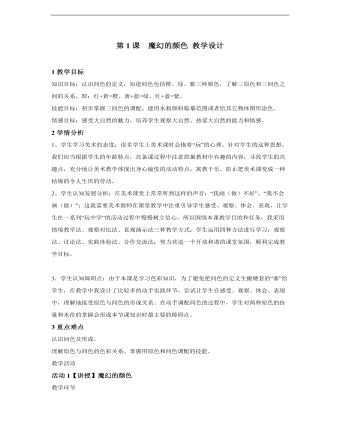
小学美术人教版三年级上册《第1课魔幻的颜色》教学设计说课稿
2学情分析1、学生学习美术的态度:很多学生上美术课时会抱着“玩”的心理,针对学生的这种思想,我们应当根据学生的年龄特点,在备课过程中注意挖掘教材中有趣的内容,寻找学生的兴趣点,充分地让美术教学体现出身心愉悦的活动特点,寓教于乐,防止把美术课变成一种枯燥的令人生厌的劳动。2、学生认知发展分析:在美术课堂上常常听到这样的声音:“我画(做)不好”、“我不会画(做)”;这就需要美术教师在课堂教学中注重引导学生感受、观察、体会、表现,让学生在一系列“玩中学”的活动过程中慢慢树立信心。所以围绕本课教学目的和任务,我采用情境教学法、观察对比法、直观演示法三种教学方式;学生运用四种方法进行学习:观察法、讨论法、实践体验法、合作交流法;努力营造一个开放和谐的课堂氛围,顺利完成教学目标。
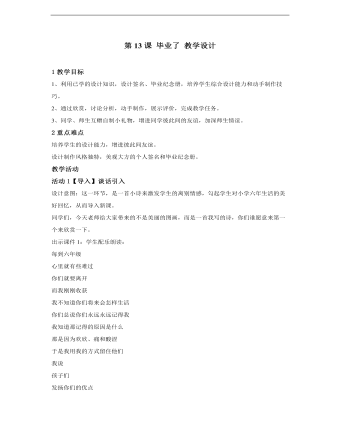
小学美术人教版六年级下册《第13课毕业啦》教学设计说课稿
活动1【导入】谈话引入设计意图:这一环节,是一首小诗来激发学生的离别情感,勾起学生对小学六年生活的美好回忆,从而导入新课。同学们,今天老师给大家带来的不是美丽的图画,而是一首我写的诗,你们谁愿意来第一个来欣赏一下。出示课件1:学生配乐朗读:每到六年级心里就有些难过你们就要离开而我刚刚收获我不知道你们将来会怎样生活你们总说你们永远永远记得我
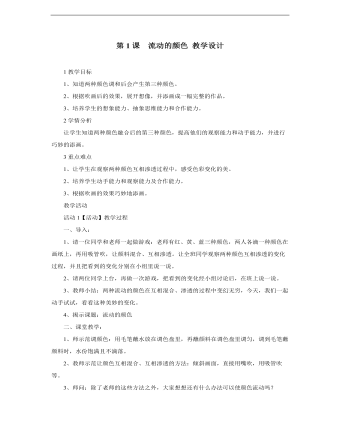
小学美术人教版二年级上册《第1课流动的颜色》教学设计说课稿
一、导入:1、请一位同学和老师一起做游戏:老师有红、黄、蓝三种颜色,两人各滴一种颜色在画纸上,再用吸管吹,让颜料混合、互相渗透。让全班同学观察两种颜色互相渗透的变化过程,并且把看到的变化分别在小组里说一说。2、请两位同学上台,再做一次游戏,把看到的变化经小组讨论后,在班上说一说。3、教师小结:两种流动的颜色在互相混合、渗透的过程中变幻无穷,今天,我们一起动手试试,看看这种美妙的变化。4、揭示课题:流动的颜色

